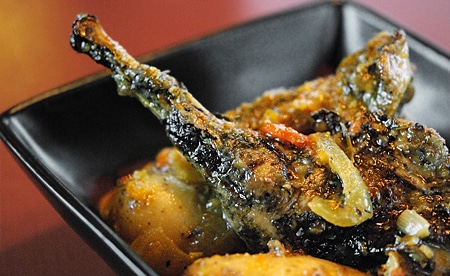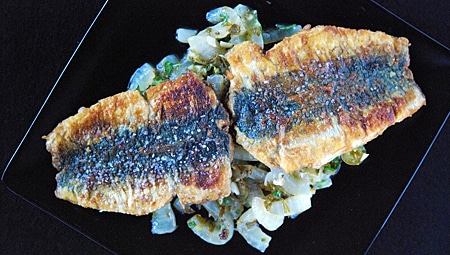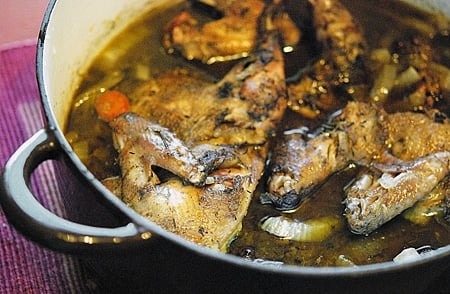As an Amazon Associate I earn from qualifying purchases.

I’ve made a lot of escabeche in my time, and read scores of recipes from all over the world. This vinegary, bracing sauce make a perfect summer lunch or dinner and is ideal for weekly lunches because escabeche keeps for days in the fridge. It’s one of my go-to dishes when the heat arrives.
But escabeche is often a hub of controversy. Who invented it? What is a “real” escabeche and which versions are poseurs? Is it a fish dish or a meat dish? Debate even surrounds the dish’s pronunciation: Es-kah-BAY-chay, Es-kah-BEH-chay or Es-kah-BESH?
The answer to all of these questions is “it depends.”
Scholars say Arabs invented the technique of cooking a meat or fish and sousing it with a vinegary sauce, probably sometime in the early medieval period. Then again, the ancient Romans were particularly fond of vinegar sauces, so I personally would put my money on either them, or the Greeks who preceded them, as the inventors.
In its modern form, escabeche is a Spanish creation, and this is the country I turn to for my own escabeche. The Spanish in turn spread the dish all over their empire in the 1500s, and what has emerged over the centuries are subspecies of the Spanish escabeche in Mexico, South America and the Philippines — and then there are the Portuguese, who can also lay legitimate claim to the dish, although every Portuguese escabeche I’ve seen has been pretty plain-Jane.
Why bother doing this? Because meat prepared this way will keep for days, even weeks if the weather is cool. And as it is most typically made with game birds or fish — both things that you can have a surfeit of after an unexpectedly good day — so semi-curing the meats makes a lot of sense.
There is another element to escabeche that needs mentioning: It is a surpassing dish for lean game birds, as the olive oil and vinegar-wine sauce keeps everything from drying out. I used a morbidly obese pheasant Holly had shot last season at a preserve for this escabeche — and while I enjoyed eating all that pheasant fat, I am pretty sure it would put off a civilian.
Red-legged partridges, or perdiz, are the classic Spanish escabeche bird; the closest thing we have to them here are chukars. That said, I have read Spanish recipes for cordoniz (quail) and faisan (pheasant), as well as American versions with the very dull Cornish game hen. If you are not a hunter and want to make this dish, please — for me — buy either a really good chicken and cut it up, or farm-raised quail or pheasants. It’s worth it.
Yes, fish escabeche is also very common, and in fact I made an Italian version of this called scapece on Sunday. It is simpler than the Spanish escabeche, and is designed to be used with oily fish such as mackerel, herring, bluefish, or, as I did, sardines. Here is the recipe.

As you can tell, the key difference between the more common seviche (also spelled ceviche) and escabeche is that you cook — often fry — the meat before it hits the vinegar sauce. That helps with the preservation and also makes sure your game birds are falling-off-the-bone tender.
I decided to switch things up this time and grill the pheasant. Normally this would have been a great idea, but with the Morbidly Obese Pheasant, fat spattered on the grill and I nearly had a grease fire on my hands. No bueno. Still, I got good color and flavor from grilling the pheasant and will do this again, especially because I can do it easily now with a gas grill.
Given all the idiosyncracies of regional escabeches, know that at least in a Spanish version there are some ingredients that must be included:
- Olive oil
- Vinegar (usually sherry)
- Thyme
- Bay leaves
- Lots of garlic
- Onion
- Black pepper
Other common ingredients include paprika, carrots, celery, parsley, rosemary, cloves and oregano. A few include olives and, as I do, saffron.
Again, regionality. Mexican escabeche uses fruit vinegars or lime juice. Portuguese versions use cider vinegar, Italians wine vinegar. Chiles or no? Mexicans and Italians say yes, but I rarely see hot chiles in either Spanish or Portuguese versions. I leave them out, as they compete with the saffron.
How hard is escabeche to make? It’s not simple, but nor is it any great feat to pull off. Mostly it takes time to get the proper browning on the bird and in simmering to get it tender.
Oh, and I know what many of you are thinking: Why not pull the meat off the bones to make it easier to eat? Yeah, I know I could. But I like getting into my food, and this sharp, rich sauce makes eating the pheasant a more primal joy. Besides, I like wiping the grease off my chin.

[recipe_name]PARTRIDGE or PHEASANT ESCABECHE[/recipe_name]
[summary]Escabeche (es-kah-BECH-ay) is an ancient preparation historically used with fish or game birds, notably the Spanish red-legged partridge, which is a cousin of our chukars here. Basically you cook the birds and then souse them with a flavorful, vinegar-based sauce for a day or three. You can eat escabeche cold, warm or at room temperature, and I typically serve it as a room temperature, summertime dinner or lunch.
I used pheasants here, but the classic is with chukars or some other form of partridge. Quail is also common, and non-hunters can either buy quail or pheasants at the market (look in the freezer section) or use Cornish game hens, which are just a baby chickens. Not as flavorful, but easier to find. Could you use a full-sized chicken cut up? You bet.
I always make this a day before I eat it, but you could leave it to marinate for as little as eight hours, i.e., make it in the morning and serve that night. It will keep in the fridge for a week or so, if it’s well-covered.[/summary]
[yield]Serves 4-6.[/yield]
Prep Time:[preptime time=45M] 45 minutes[/preptime]
Cook Time:[cooktime time=3H] 3 hours[/cooktime]
- [ingredient] [amount]2[/amount] [item]pheasants[/item] or [amount]4[/amount] [item]chukars[/item] or [amount]8[/amount] [item]quail[/item] [/ingredient]
- [ingredient] [amount]1/3 cup[/amount] [item]olive oil[/item] [/ingredient]
- lemon peel from 1 lemon, white pith removed
- [ingredient] [amount]1/2 cup[/amount] [item]sherry vinegar[/item] or [item]white wine vinegar[/item] [/ingredient]
- [ingredient] [amount]3 cups[/amount] [item]white wine[/item], preferably Spanish [/ingredient]
- [ingredient] [amount]6[/amount] [item]bay leaves[/item] [/ingredient]
- [ingredient] [amount]1 teaspoon[/amount] [item]dried thyme[/item] [/ingredient]
- [ingredient] [amount]1 teaspoon[/amount] [item]black pepper[/item] [/ingredient]
- [ingredient] [amount]1 sprig[/amount] [item]rosemary[/item] [/ingredient]
- [ingredient] [amount]2[/amount] [item]cloves[/item] [/ingredient]
- [ingredient] [amount]1 head[/amount] of [item]garlic[/item], peeled [/ingredient]
- [ingredient] [amount]1[/amount] [item]onion[/item], sliced into half-moons [/ingredient]
- [ingredient] [amount]2[/amount] sliced [item]carrots[/item] [/ingredient]
- [ingredient] [amount]1/2 teaspoon[/amount] [item]saffron[/item] [/ingredient]
- Salt
[instructions]
- Cut your birds into serving pieces (leave quail whole) and salt them well. Set aside.
- Heat the olive oil in a large Dutch oven or pot with a lid over medium heat and cook the lemon peel in the oil until it browns. Remove and either discard or eat (it’s tasty!). This adds another layer of flavor to the escabeche.
- Cook the birds. You have two choices here. Either brown them in the olive oil you just flavored with lemon, or paint them with some more olive oil and grill them over an open fire. I do the former in winter, the latter in summer.
- Saute the onion in the lemon-flavored olive oil until just beginning to brown. Remove about half and set aside.
- Add the carrots and garlic and saute for a few minutes, stirring often.
- Pour in the vinegar, white wine, all the herbs and spices — except the saffron — and bring to a simmer.
- Put in the pheasant, quail or chukars and add a little water if you need more liquid: You want the birds to be almost submerged, but not completely so. Cover and simmer slowly for 90 minutes.
- Remove the birds and discard the bay leaves.
- Buzz the sauce with an immersion blender, push it through a food mill set on a medium setting, buzz it in a food processor or a blender — do something to puree the sauce.
- Return it to the pot, add the saffron and bring to a simmer. Stir well and return the birds to the sauce. Turn off the heat and cover. Let the birds cool in the sauce for an hour or so.
- Serve cold, warmed up or at room temperature with white wine or beer, and either boiled potatoes or lots of crusty bread.
[/instructions]




Hank, just had a what I assume is a similar dish in a Madrid wine bar. The “fais’an” had been sealed in jars, it was heavy on peppercorns and bay leaves and was served cold with bread. The waiter claimed it had been “brined and cured” with no actual cooking going on besides in the jar but I suspect that the Abuela that made the dish for the bar was braising or frying prior to picking the meat, saucing, and jarring the dish. Would love to here your thoughts on “canning” something like this.
I am making this tonight and it looked just like yours until I pureed the cooking medium. Now it looks like chunks of pheasant in a carrot puree. How do I turn this around?
I totally understand the primal thing. I tend to make more rustic dishes myself.
Thanks for the info as well!…oh and I put up your last post on my facebook! : p : )
Very informative post. I’ve always associated escabeche with fish, never with meat. I’m gonna have to rethink that now.
wow… i’d love to try your escabeche with meat. we just made it similar to the one we eat in our local haitian restaurant which is pretty much jamaican style. you are so right that it is the perfect thing to eat in the summertime.
K: Great resource! I downloaded the two ancient recipes he included in that report.
Josh: Stop complicating things!
Matt: Buy a gun. Learn to hunt. Eat better.
Long Time in China: VERY cool! If you’d asked me if the Chinese did something like escabeche, I’d say probably, but it would have been a wild guess. I may make this version and see how it goes. Thanks for sharing it.
My wife’s hometown (Yongzhou, Hunan Province, China) has their own version of chicken escabeche with typical Asian seasonings – ginger, Sichuan peppercorns, spicy “burn-ya-twice-as-nice” chillies, salt, white pepper and white vinegar.
Likewise it is a fabulous dish for the summertime. Likewise it is cooked first – either steamed or boiled just to where the marrow is still red but the meat is cooked through (usually boiled to have some soup for other applications, like mung bean noodles); and then soused with vinegar and ginger and all that other and stir-fried a second until it concentrates some. It is not suggested to serve it hot, but rather after it has cooled to about room temp (which here in summer is sweltering).
I’ve only ever seen it in her hometown, actually, and most other folk I talk to think it strange to rave about a vinegary chicken. But i think it is freakin’ awesome, as do the millions from the small town where she grew up.
Morbidly Obese Pheasant is right. Just polished off the last of that bird and it was as fat as the domestic duck I ate a couple years ago at Les Halles in NYC. Unseemly, really – especially after you’re used to nice lean game animals.
you keep making me want to buy a gun.
Man, that looks extremely good. Right up my alley.
I’ll add to the pronunciation debate –
esca-VE-che.
It might interest you to know that Dan Jurafsky’s invited speech at the latest NAACL meeting included an ethymology of escabeche which he claims can be derived from a Persian dish “sikbaj”. The slides from the presentation can be found here. The history lesson starts at slide number 30.